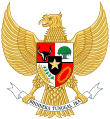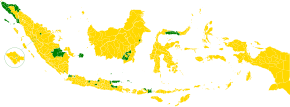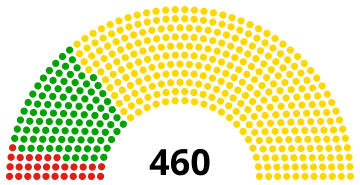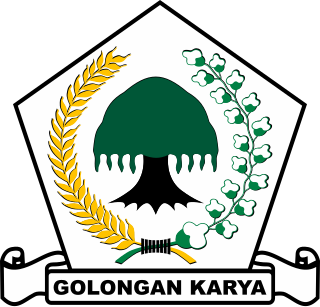
The Party of Functional Groups, often known by its abbreviation Golkar, is a political party in Indonesia. It was founded as the Joint Secretariat of Functional Groups in 1964, and participated for the first time in national elections in 1971 as Functional Groups. Golkar was not officially a political party until 1999, when it was required to become a party in order to contest elections.

The United Development Party is an Islamist political party in Indonesia. Due to its distinctive logo, the party is known as the "Kaaba Party".

The National Awakening Party, frequently abbreviated to PKB, is an Islam-based political party in Indonesia.
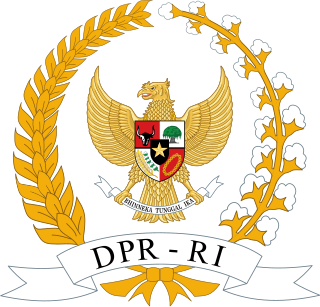
The People's Representative Council of the Republic of Indonesia, is one of two elected chambers of the People's Consultative Assembly (MPR), the national legislature of Indonesia. It is considered the lower house, while the Regional Representative Council (DPD) serve as the upper house; while the Indonesian constitution does not explicitly mention the divide, the DPR enjoys more power, privilege, and prestige compared to the DPD.

Elections in Indonesia have taken place since 1955 to elect a legislature. At a national level, Indonesian people did not elect a head of state – the president – until 2004. Since then, the president is elected for a five-year term, as are the 575-member People's Representative Council, the 136-seat Regional Representative Council, in addition to provincial and municipal legislative councils.

The Indonesian Democratic Party was one of the two state-approved parties during the New Order era of the late 20th-century in Indonesia.

Sudharmono, also known by his nickname, Pak Dar, was an Indonesian politician and army officer, who served as the fifth vice president of Indonesia, under the New Order regime of president Suharto, serving from 1988 until 1993. Previously, he served in several positions in the government and military, including as the Chairman of Golkar, State Secretary of Indonesia, and a Lieutenant General in the army.
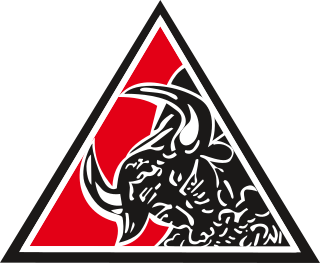
The Indonesian National Party was the name used by several nationalist political parties in Indonesia from 1927 until 1973. The first PNI was established by future President Sukarno. After independence, the new PNI supplied a number of prime ministers, and participated in the majority of cabinets in the 1950s and 1960s. The party was fused into the Indonesian Democratic Party in 1973. In the years following the reforms of the late 1990s, a number of parties claiming to be the continuation of previous PNIs stood in elections, but gained only a handful of seats.

The People's Consultative Assembly of the Republic of Indonesia is the legislative branch in Indonesia's political system. It is composed of the members of the House of Representatives (DPR) and the Regional Representative Council (DPD). Before 2004, and the amendments to the 1945 Constitution, the MPR was the highest governing body in Indonesia.

Legislative elections were held in Indonesia on 3 July 1971, the first under the New Order regime. There were ten participants; nine political parties and the "functional group" Golkar, which came first with more than 60 percent of the vote, resulting in an absolute majority in the People's Representative Council.

Legislative elections were held in Indonesia on 4 May 1982. They were the fourth legislative elections since independence and the third under the New Order regime There were three participants; the two political parties, the United Development Party (PPP), the Indonesian Democratic Party (PDI) and the "functional group" Golkar. As with all elections during the New Order regime, the government-backed Golkar organization won an absolute majority.

Legislative elections were held in Indonesia on 23 April 1987, to elect 400 of the 500 members of the People's Representative Council (DPR), the national legislature. The election was the fifth legislative election in the country since independence and the fourth legislative election under President Suharto's New Order. The election resulted in an outright majority for Golkar, which retained its status as the ruling party of the country.
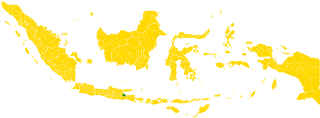
Legislative elections were held in Indonesia on 9 June 1992, to select 400 of the 500 members of the People's Representative Council (DPR). The election was the sixth legislative elections since Indonesian independence and the fifth legislative elections under the New Order regime of president Suharto. The election resulted in a clear victory for Golkar, which retained its status as the ruling party, although the opposition, under the United Development Party (PPP) and the Indonesian Democratic Party (PDI), saw their vote shares rise.

Early legislative elections were held in Indonesia on 7 June 1999. They were the first elections since the fall of Suharto and end of the New Order, and the first free elections in Indonesia since 1955. With the ending of restrictions on political activity following the fall of Suharto, a total of 48 parties contested the 462 seats up for election in the People's Representative Council. A further 38 seats were reserved for members of the armed forces.

Mohammad Guruh Irianto Sukarnoputra is a member of Indonesia's People's Representative Council and an artist. He is the youngest son of Indonesia's first president, Sukarno with his third wife, Fatmawati, and a brother of former Indonesian president Megawati Sukarnoputri.

The 27 July Incident was an attack by Indonesian government forces on the head office of the Indonesian Democratic Party, which was being occupied by supporters of recently ousted party leader Megawati Sukarnoputri. It was followed by two days of riots in Jakarta.

The Speaker of the House of Representatives, is the presiding officer of the House of Representatives of Indonesia. The speaker is the political and parliamentary leader of the House of Representatives and is simultaneously the Council's presiding officer. The speakers also perform various other administrative and procedural functions.

Union of Islamic Education, also known as PERTI, is a Shafii-Ash'ari Islamic organization in Indonesia. The organization was founded by Sulaiman ar-Rasuli on May 5, 1928 in Candung, West Sumatra. In its development, PERTI had become a political party and gained four People's Representative Council (DPR-RI) seats and seven Constituent seats in 1955 general election.

The Indonesian Democratic Union Party,, was a political party founded by Sri Bintang Pamungkas in 1995 and one of the political parties in Indonesia that participated in the 1999 general elections.
